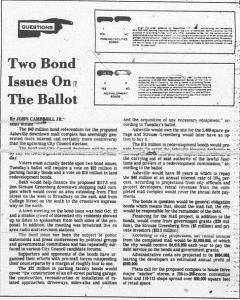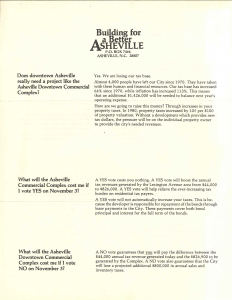“A YES vote costs you nothing… A Yes vote will help relieve the ever-increasing tax burden on residential taxpayers.”
–Building a Better Asheville

The reality of the proposed Asheville Downtown Commercial Complex would come down to a struggle over financing. The overall cost of the project was $117,592,000 with $20 million of that expected to come from government grants. Sager notes that of the $4.5 billion in grant applications, the United States Department of Housing and Urban Development (HUD) received in 1979, only $150 million was paid out meaning that Asheville couldn’t count on much, or any, of that money coming to them. Planners explored other funding options from other areas like Economic Development Assistance and Appalachian Regional Commission, but the prospect of getting funding from about anywhere was dim. $40 million worth bonds would have to be sold to taxpayers for this project to happen., which meant that funding for the effort would require the city to vote for approval. Thus began the political fight to build a better Asheville. [ref]Sager, Molly. “The Mall That Almost Ate Asheville: The Fight between City Hall and Save Downtown Asheville Inc. Over the the Strouse, Greenberg & Company Downtown Commercial Complex.” Undergraduate thesis, University of North Carolina Asheville, 2012. 15-22.[/ref]

Sager notes that the Asheville Citizen and the evening paper, The Asheville Times, routinely published articles concerning the mall project. The majority of these articles and the local television station, WLOS, heavily favored the city’s point of view. On October 23, 1981 the local media hosted a debate where pro mall advocates Sister Veronica Schumacher, Walter Gladding, a local Asheville banker, and City Planner Jim Daniels, argued for the proposal on economic grounds, including the hope to combat the shrinking tax revenue of the city. However, their efforts proved too little. Sager goes on to show that on November 3, 1981, Asheville voters opted by a margin of 2 to 1 against the issuing of bonds to purchase the 11-city block area in downtown Asheville. Without a back up plan the Asheville City Council was left with nothing. The cities refusal on the bond vote left any hope of the commercial project “nigh on to death”, explained Joe Lawrence of Strouse-Greenberg’s Charlotte office. After the failed bond vote the proposed mall lost all its backers. Support for the Downtown Commercial Complex collapsed and the mall that stood to change Downtown Asheville forever never happened.[ref]Sager[/ref]
